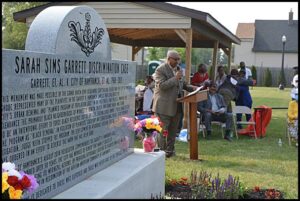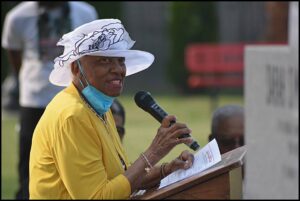Hamtramck’s newest park marks an injustice finally made right

Last Wednesday, a dedication ceremony was held for the city’s newest park, Sarah Sims Garrett, and the monument that honors Garrett and other plaintiffs involved in a housing discrimination lawsuit filed against the city back in the early 1970s.
By Charles Sercombe
After a year’s delay in dedicating Hamtramck’s newest park, it finally got done last Wednesday.
But then again, in the case of this park, delays and waiting are a common theme.
We’re talking about the dedication of the Sarah Sims Garrett Park, and the monument to the woman, and others, who were being honored with this park. A dedication ceremony was going to be held last year but that was canceled due to a citywide flooding that happened after heavy rains.
The story about the park and monument is the legacy of a long story — over 50 years long — that involves an ugly episode in Hamtramck’s past.
The park and monument are dedicated to a long-gone group of people, 200 people to be exact, who filed a class-action lawsuit against Hamtramck in a housing discrimination lawsuit in the early 1970s.
The lawsuit was the result of city officials in the 1960s razing neighborhoods where a majority of the residents were African-Americans.
That action was done under the guise of a nation-wide, federally-funded program called “Urban Renewal.” The program was meant to remove blight in the inner cities and improve community life.
When the residents wised up to the fact that they were being racially targeted, they filed a lawsuit in federal court.
A Detroit federal judge, Damon Keith, an African-American civil rights champion, called the action by city officials “Negro Removal,” in an obvious reference to the Urban Renewal program.
And so, a decades-long lawsuit was born. Sarah Sims Garrett was one of those people who were wronged, and, as the story goes, she volunteered to have her name used for the class action lawsuit.
Garrett died long before the lawsuit was finally settled. But that settlement ultimately required the city to build 200 housing units – one for each plaintiff. The last three houses are just now being built.
The plaintiffs, like Garrett, are now deceased, but some of their descendents are still alive, and qualify to purchase the new housing (with the assistance of federal funding).

Vera Burk was one of many people who were instrumental in settling a housing discrimination lawsuit filed against the city by African-American residents.
Although Garrett never saw the conclusion of the lawsuit, city officials and others involved in the federal lawsuit created this park out of vacant land on the southbound side of the I-75 service drive at Caniff.
Vera Burk, an African-American who was chairman of the Grand Haven-Dyar-Dequindre Corporation, one of the two corporations set up to mediate a settlement with the city, said the road to settling the lawsuit “was a struggle.”
“I love my Hamtramck, but it was a struggle,” she added.
At the park ceremony, attended by about 50 people, several spoke.
Hamtramck Mayor Amer Ghalib was one of the first to weigh in.
He prefaced his remarks saying that he took “time away” from his family to attend the dedication. He promised that housing injustice “will never happen again.”
“In this city, we all belong to minorities:” said Ghalib, the city’s first Yemeni-American to become mayor.
Gilda Keith, a daughter of federal judge Damon Keith (who went on to oversee the case for many years, but died before the last of the housing was built) said this case was the definition of the saying: “Justice delayed is justice denied.”
Former mayor Karen Majewski, who was unable to attend, was in office for 16 years as this lawsuit progressed.
Her statement was read by city council candidate Lynn Blasey. Majewski said:
“We come to dedicate this park in order to help rebuild community, to rebuild trust, to rebuild hope; we do so in partnership with, and in honor of, the African American community which has suffered, and which has prevailed.
“A park is not an answer to that injustice. But it is an outstretched hand, a place for contemplation and healing, where we can all be reminded that restitution has no expiration date, and that those who’ve fought the good fight deserve to be remembered, and honored.”
Former city manager Kathy Angerer, who helped create the park, said all credit for the park belongs to “the tenacity of the plaintiffs” of the lawsuit.
Angerer said that this park represents “a place of peace, a place of contemplation so we never forget the injustice that happened many years ago, and we don’t repeat such an injustice in our time.”
Little is known about Sarah Sims Garrett, but a childhood friend was at the dedication. Barbara Bradford said that Garrett was “first and foremost a Christian, and child of God.”
Asked what would be going through Garrett’s mind on the day’s park dedication, Bradford said her friend would have surely said one word: “Hallelujah.”
Posted July 7, 2023


Mark Koroi
July 9, 2023 at 9:39 pm
As of 2017, the Plaintiffs were alleging in Court proceedings bias with respect to property tax assessment by the City of Hamtramck and seeking relief. The American Civil Liberties Union filed papers in support of the civil rights litigants:
http://www.aclu.org/en/cases/housing-discrimination-hamtramck
A 1974 U.S. Sixth Circuit Court of Appeals opinion had recognized racial prejudice in the government of the City of Hamtramck:
“There is also considerable evidence of racism and prejudice against Negroes on he part of city officials.”
This article incorrectly indicates that the Garrett case was filed in the 1970s.
Actually, the landmark opinion of Judge Damon Keith was issued on November 22, 1971 – but Ms. Garrett’s case had been filed initially in 1968 as the product of a project of the University of Detroit Law School as an urban law program.
Mark M Koroi
July 10, 2023 at 2:20 pm
Corrected link to ACLU Michigan:
http://www.aclumich.org/en/cases/housing-discrimination-hamtramck